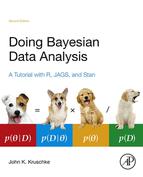Table of Contents
Chapter 1: What's in This Book (Read This First!)
1.1 Real people can read this book
1.3 What's new in the second edition?
1.4 Gimme feedback (Be polite)
Part I: The Basics: Models, Probability, Bayes’ Rule, and R
Chapter 2: Introduction: Credibility, Models, and Parameters
2.1 Bayesian inference is reallocation of credibility across possibilities
2.2 Possibilities are parameter values in descriptive models
2.3 The steps of bayesian data analysis
Chapter 3: The R Programming Language
3.2 A simple example of R in action
3.3 Basic commands and operators in R
3.8 Graphical plots: Opening and saving
Chapter 4: What is This Stuff Called Probability?
4.1 The set of all possible events
4.2 Probability: Outside or inside the head
4.5 Appendix: R code for figure 4.1
5.2 Applied to parameters and data
5.3 Complete examples: Estimating bias in a coin
5.4 Why bayesian inference can be difficult
5.5 Appendix: R code for figures 5.1, 5.2, etc.
Part II: All the Fundamentals Applied to Inferring a Binomial Probability
Chapter 6: Inferring a Binomial Probability via Exact Mathematical Analysis
6.1 The likelihood function: Bernoulli distribution
6.2 A description of credibilities: The beta distribution
6.6 Appendix: R code for figure 6.4
Chapter 7: Markov Chain Monte Carlo
7.1 Approximating a distribution with a large sample
7.2 A simple case of the metropolis algorithm
7.3 The metropolis algorithm more generally
7.4 Toward gibbs sampling: Estimating two coin biases
7.5 Mcmc representativeness, accuracy, and efficiency
8.1 Jags and its relation to R
8.3 Simplified scripts for frequently used analyses
8.4 Example: difference of biases
8.5 Sampling from the prior distribution in jags
8.6 Probability distributions available in jags
8.7 Faster sampling with parallel processing in runjags
8.8 Tips for expanding jags models
Chapter 9: Hierarchical Models
9.1 A single coin from a single mint
9.2 Multiple coins from a single mint
9.3 Shrinkage in hierarchical models
9.5 Extending the hierarchy: Subjects within categories
Chapter 10: Model Comparison and Hierarchical Modeling
10.1 General formula and the bayes factor
10.2 Example: two factories of coins
10.4 Prediction: Model averaging
10.5 Model complexity naturally accounted for
10.6 Extreme sensitivity to prior distribution
Chapter 11: Null Hypothesis Significance Testing
11.1 Paved with good intentions
11.3 Confidence interval and highest density interval
11.5 What a sampling distribution is good for
Chapter 12: Bayesian Approaches to Testing a Point (“Null”) Hypothesis
12.2 The model-comparison approach
12.3 Relations of parameter estimation and model comparison
12.4. Estimation or model comparison?
Chapter 13: Goals, Power, and Sample Size
13.2 Computing power and sample size
13.3 Sequential testing and the goal of precision
14.4 Specify models top-down in stan
Part III: The Generalized Linear Model
Chapter 15: Overview of the Generalized Linear Model
15.2 Linear combination of predictors
15.3 Linking from combined predictors to noisy predicted data
15.4 Formal expression of the GLM
Chapter 16: Metric-Predicted Variable on One or Two Groups
16.1 Estimating the mean and standard deviation of a normal distribution
16.2 Outliers and robust estimation: The t distribution
16.4 Other noise distributions and transforming data
Chapter 17: Metric Predicted Variable with One Metric Predictor
17.3 Hierarchical regression on individuals within groups
17.4 Quadratic trend and weighted data
17.5 Procedure and perils for expanding a model
Chapter 18: Metric Predicted Variable with Multiple Metric Predictors
18.1 Multiple linear regression
18.2 Multiplicative interaction of metric predictors
18.3 Shrinkage of regression coefficients
Chapter 19: Metric Predicted Variable with One Nominal Predictor
19.1 Describing multiple groups of metric data
19.2 Traditional analysis of variance
19.3 Hierarchical bayesian approach
19.4 Including a metric predictor
19.5 Heterogeneous variances and robustness against outliers
Chapter 20: Metric Predicted Variable with Multiple Nominal Predictors
20.1 Describing groups of metric data with multiple nominal predictors
20.2 Hierarchical bayesian approach
20.3 Rescaling can change interactions, homogeneity, and normality
20.4 Heterogeneous variances and robustness against outliers
20.6 Model comparison approach
Chapter 21: Dichotomous Predicted Variable
21.1 Multiple metric predictors
21.2 Interpreting the regression coefficients
21.3 Robust logistic regression
Chapter 22: Nominal Predicted Variable
22.2 Conditional logistic regression
22.4 Generalizations and variations of the models
Chapter 23: Ordinal Predicted Variable
23.1 Modeling ordinal data with an underlying metric variable
23.2 The case of a single group
23.4 The case of metric predictors
23.6 Generalizations and extensions
Chapter 24: Count Predicted Variable
24.1 Poisson exponential model
24.2 Example: hair eye go again
24.3 Example: interaction contrasts, shrinkage, and omnibus test
24.4 Log-linear models for contingency tables
Chapter 25: Tools in the Trunk
25.1 Reporting a bayesian analysis
